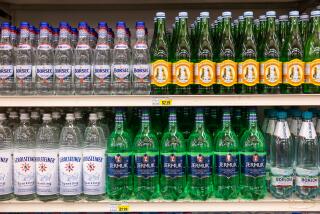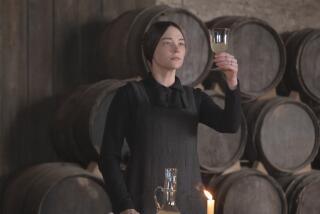The Other Eaux
The American guru of distilling fruit and grapes into fine eaux-de-vie is a former lawyer and administrative court judge from Germany. Without having sought much publicity, he has turned out some of the finest spirits made in the United States.
Jorg Rupf started St. George Spirits in Emeryville near Oakland in 1982, before much fine distilling was going on. Until then, most of the stills in the United States were large continuous stills used for making whiskies and brandies.
âMy family had been in the business in the Black Forest for generations,â says Rupf, adding that he is surprised so little fine eaux-de-vie is made here.
Today, largely because of Rupf, a revolution is going on in eaux-de-vie . More than a dozen California wineries have begun to make grappa and liqueurs from grapes, pomace or fruits. Production of most of these is small because itâs an expensive process, but the quality is very high.
Rupfâs two-still operation produces sublime eaux-de-vie. The basic product is what Rupf calls alcohol blanc-- a distillate aged in glass, not oak, that carries the aroma and taste of the fruit or grapes from which it was made. St. George makes three fruit-based eaux-de-vie , from pears ( poire ), cherries ( kirsch ) and raspberries ( framboise ).
The latter is the most intense. Thatâs because he steeps fresh raspberries in the clear liquid. âThe framboise lends itself to this process because the fruit is very robust,â he says. âThe pear and the cherry would oxidize too rapidly.â
These products take a lot of fruit. He said it takes 15 pounds of pears to distill the amount of liquid in a 375-milliliter bottle.
Recently Rupf has been developing a grappa from wine grapes that will show the varietal character of the grape after distillation.
âWe make one from Zinfandel, which is more like classical grappa,â he says. Another product is called Grappa de Traminer. For it, he takes the whole grape, makes a wine on the skins and then distills and ages it as would an Italian making aquavite de uva.
âBut we have a problem,â says Rupf. âThe Bureau of Alcohol, Tobacco and Firearms does not recognize varietal designations on brandy, so we call it grappa.â
Half-bottles of St. Georgeâs eaux-de-vie are between $15 and $18. The liqueurs sell for about $10.
Rupf helped Oregonâs Clear Creek Distillery get off the ground and he remains an investor in the Clear Creek operation.
âClear Creek heard about us,â says Rupf. âStephen McCarthy came to visit me, and I was probably the only one doing this at the time, so I decided it was better to have a few people making this than just one guy.â
Rupf helped McCarthy obtain two stills and became a shareholder. âHe had the financial resources to really do all the marketing things I was never able to do,â said Rupf. âBesides, he has those Hood River Valley pears, which are great.â
St. George now also has dessert wines that are similar to liqueurs. âBut the tenor is a little different because they are made like Ports,â he says. âWe fermented the fruit and stopped the fermentation with brandy made from the same fruit.â
Is there a great market for these products? Not yet, says Rupf, but heâs âhaving fun.â
The eau-de-vie game has heated up in the last three years, with many wineries dabbling in it. Nick Martin of Martin Bros. Winery in Paso Robles makes two grappas, one from Nebbiolo grapes ($40 for a 750-milliliter bottle) and one from the more aromatic grape Aleatico ($18 for a 375-ml bottle). Both are distilled at St. George Spirits by Rupf.
âIt takes huge amounts to make a good one,â says Martin. He sent 2,000 gallons of Nebbiolo wine (the equivalent of 10,000 bottles) and 10 tons of Nebbiolo pomace by truck to St. George. All that produced only 4,000 bottles of grappa.
âThen they kill you on the tax,â he says. State tax is $2 per proof gallon and federal tax is $13.50 per proof gallon.
âAfter farming and harvesting costs, the cost to make wine, the cost to ship everything to Jorg and then back here, and the cost of the packaging, we figure it probably costs us $25 to make a bottle of that stuff. But I love it.â
Andrew Quady of the Madera-based Quady Winery makes a wonderful fortified dessert wine called Elysium from Black Muscat grapes. Quadyâs âSpirit of Elysiumâ retains the intense Muscat aroma found in the wine. It retails for $25 for a 750-ml bottle.
One of the most amazing products Iâve tasted is from Mosby Winery in Buellton. Its Distillato di Prugne Selvaggie (a distillation of wild plums) is one of the finest, most aromatic liquids I have ever tasted or smelled.
âI used to pick these things in Klamath Falls, Ore., and make jam out of them, so I thought Iâd try a little for grappa,â said Bill Mosby. He made just 4,000 bottles of the wild plum grappa and charges $32 for a 375-ml bottle. His sensational Grappa di Traminer is $25.
Creekside Winery in Suisun makes an excellent apple brandy; Bonny Doonâs Caâ del Solo âPrunusâ ($15/375-ml) is a blend of three fruits; Sebastiani Vineyards made about 600 cases each of Muscat, Zinfandel and Barbera grappas. They sell for $24 per 500-ml bottles. San Francisco chef Narsai David recently released grappa from grapes grown on his Napa Valley ranch that is exceptional. Itâs $80 a bottle.
Another specialist in distillation and related eaux-de-vie is Miles Karakasevic, whose family, he says, have been distillers for centuries. He was educated at the University of Belgrade and worked at Geisenheim, Germany, in fermentation science.
Karakasevic founded Domaine Karakash in the Napa Valley in 1983. Originally a brandy producer, Karakasevic now specializes in truly fine products rarely made in the United States--or anywhere.
For instance, his Charbay is a blend of aged brandy and Chardonnay. At $5.25 for a 187-milliliter bottle, itâs enough for four aperitif servings, chilled or over ice.
Karakasevic is proudest of his Calvador, an apple brandy aged for years in French oak casks until it has the intensity of Calvados taken to extremes. It is not cheap: $87 for a 200-milliliter bottle.
At the same price is Nostalgie, which uses an eau-de-vie base in which crushed black walnuts have been steeped for nine months. The result is an amazingly complex liquid that has characteristics similar to a great old oloroso Sherry and an ancient Rutherglen Muscat.
Karakasevic is also working on eau-de-vie from persimmon as well as traditional non-oak aged grappa.
More to Read
Eat your way across L.A.
Get our weekly Tasting Notes newsletter for reviews, news and more.
You may occasionally receive promotional content from the Los Angeles Times.










